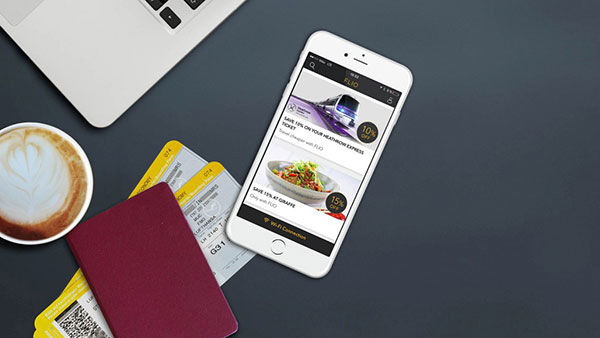
While airport apps can be a useful day of travel tool, their relevance has been questioned on a number of occasions. For frequent travellers who pass through dozens of different airports over the course of a year, the likelihood of them downloading and keeping a dedicated app for each is slim, especially when many of the most vital features – boarding passes and frequent flyer accounts, for instance – are reserved for airline apps.
The challenge airports (and airlines) face in getting people to use their apps was highlighted in our interview with Facebook’s Head of Travel last year. Lee McCabe explained that “the average person only has 26 apps, so for travel the average person will never have a lot of travel apps”. So what’s the solution? Many have raised the idea of creating a single, all-encompassing app to cover the world’s airports, which is exactly what FLIO has set out to achieve. The iOS app was launched in August 2015 and already offers content for more than 200 airports – from San Francisco to London Heathrow to Incheon. This month the Android app went live, making FLIO available to millions more travellers.
Speaking to FTE, Stephan Uhrenbacher, founder of FLIO, explained the motivation behind the creation of FLIO. “As a businessman I have always found airports fascinating,” he said, “as the commercial opportunities are so amazing and at the same time as a passenger, and I am a frequent flyer, I have almost always found them to be a frustrating and stressful experience. Many airports do in fact offer a lot that improves the passenger experience, but it is my experience that they are not very effective in communicating this. It is this experience that inspired me to do something about it.”
Uhrenbacher describes himself as a “veteran of the “local” space on the internet”. He previously founded Qype, which evolved into the largest local reviews website in Europe and was sold to Yelp for a figure believed to be in the region of $50 million in 2012.
“It always was clear to me that traditional approaches to “local” did not work in airports. Google Maps is more for cities,” he explained. “Review websites don’t work because passengers don’t have the time to read through reviews. The defining moment that finally prompted me to actually go forward with FLIO was when I began to discover that even the largest airports don’t have enough leverage with users to build a compelling app that a user will download. Nobody wants more than one airport app.”
Increasing revenues and improving the passenger experience
FLIO has a big commercial focus by way of offering discounts on food and beverage, duty free shopping and lounge access at participating airports. However, it has also been designed to simplify the airport experience. For instance, it hosts real-time arrivals and departures times, live security wait times where possible, hints and tips on where to find things like charging points and onward transport options, booking and payment functionality for these ancillary services, and it also makes it easier for travellers to connect to airport Wi-Fi. Instead of having to login at every airport, FLIO stores the Wi-Fi data and manages the login process for users, so the passenger doesn’t have to manually fill in a digital form every time, while the airport gets the same data as they would with a manual login process.
The benefits for the user are clear, but FTE couldn’t help but question why airports are partnering with FLIO when it appears to compete directly with their own in-house developed apps. Uhrenbacher responded: “The perception of FLIO has totally changed in our discussions. Before we launched, many airport IT departments saw us as an unnecessary duplication and even a competitive element to their own efforts. Since our launch, we have been able to convince many airports to see us as a complementary offer to their own apps. After all, we are both trying to help their passengers get the best experience from their airports and through the course of that to generate non-aeronautical revenue as well.

“It is extremely hard for one airport on its own to convince passengers to download an app. And even the largest airports admit that once people have downloaded an individual app, it is even much harder to get people to open the app and use it. FLIO takes content streams, information and makes these available to all passengers who have used the app before at another airport. We have seen many airports changing their attitude towards us and working with us, while at the same time figuring out their own approach. The same is true for some retailers.”
As with many things in the air transport industry, everyone involved could benefit from closer collaboration and more effective data sharing, as Uhrenbacher outlined. “Security wait times are being protected like state secrets. Belt numbers for baggage seem to be impossible to get to. Everyone is protecting their data. But if you really ask airports and retailers what they know about their passengers, it is in reality much less than they would like it to be.”
He continued: “FLIO already today has much more data: we know which airports a passenger has been to since they started using FLIO. We know already which vouchers they have used. For some FLIO users we know their Facebook profile. And we can send push messages to our users if needed. We are of course obliged to protect individual user’s data, but we believe that we can provide aggregated statistics and anonymised individual data for airports that are much better than what an individual airport can gather. So our approach is simple with airports. We ask them to share technical data like waiting times and other information and we give them back valuable information for their own marketing efforts, which they would otherwise not get.”
Uhrenbacher and his team have also started the process of speaking to airlines about working with FLIO – “the discussions are at an early stage” – but a reluctance to share data must be overcome on this front, too. “Airports can be very protective about their data and airlines can be very protective about their data, but airlines have a lot more of it,” Uhrenbacher said.
Airport apps should evolve to remain relevant
With more than 70,000 downloads of the FLIO iOS app already achieved in just a five-month period, the new Android app, which can automatically tell whether the user is at the pre-security, post-security or arrivals stage of their journey, presents a huge source of potential growth. In fact, within five years FLIO is aiming to have a user base in the “double-digit millions”.
If it can achieve this, all eyes will be on airports (and perhaps even airlines) to see if their own apps have remained relevant. Uhrenbacher is clear on the fact that he does not see FLIO as direct competition to airports’ own products, but if a single app ends up providing more value than hundreds of individual airport apps put together, travellers will have a relatively simple decision to make when deciding which one to download ahead of their journey.
FLIO aside, Uhrenbacher seems certain that change is on the horizon. “Independent of FLIO’s progress, I would be willing to bet that 10 years from now an app for every airport could become a thing of the past unless every airport will find a way to convince users to use their own dedicated airport app,” he stated.
The onus is now on airports, and at least to some extent airlines, to ensure they develop apps that travellers quite simply cannot afford to ignore.







